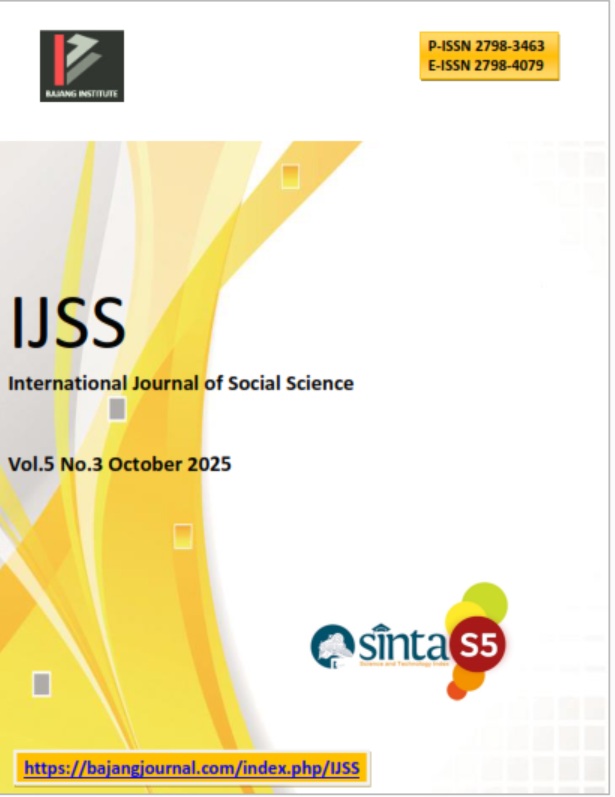EFFECTS OF INSTRUMENTAL AND VOCAL MUSIC THERAPY ON BETA-ENDORPHIN RELEASE AND STRESS REDUCTION: A CONTROLLED EXPERIMENTAL STUDY
DOI:
https://doi.org/10.53625/ijss.v5i3.11508Keywords:
Music Therapy, Beta-Endorphin, Stress Reduction, Vocal And Instrumental InterventionAbstract
Chronic stress is a pervasive global health issue linked to psychological and physiological disorders. Music therapy has emerged as a non-invasive, cost-effective intervention with demonstrated benefits in emotional regulation and neurochemical modulation. Among its proposed mechanisms is the stimulation of beta-endorphin production, a neuropeptide associated with pain relief, mood enhancement, and stress reduction. This study aimed to evaluate the effects of instrumental and vocal music therapy on beta-endorphin hormone levels and subjective stress reduction in adults experiencing moderate to high stress A randomized controlled trial was conducted involving 90 participants aged 18–45 with self-reported stress levels above the clinical threshold. Participants were randomly assigned to three groups: instrumental music therapy, vocal music therapy, or a no-intervention control. Each intervention group received 30-minute music therapy sessions three times per week for four weeks. Serum beta-endorphin levels were measured pre- and post-intervention using ELISA assays. Subjective stress was assessed using the Perceived Stress Scale (PSS). Both instrumental and vocal music therapy groups showed significant increases in beta-endorphin levels compared to the control (p < 0.01), alongside marked reductions in PSS scores (p < 0.001). Vocal therapy demonstrated a slightly higher effect size. Instrumental and vocal music therapy significantly enhance beta-endorphin secretion and reduce perceived stress, suggesting their utility as complementary interventions in stress management protocols.
References
Aalbers, S., Fusar-Poli, L., Freeman, R. E., Spreen, M., Ket, J. C., Vink, A. C., Maratos, A., Crawford, M., Chen, X. J., & Gold, C. (2017). Music therapy for depression. Cochrane Database Syst Rev, 11(11), Cd004517. https://doi.org/10.1002/14651858.CD004517.pub3
Abrams, B. (2003). Wigram, T., Pedersen, I. N., & Bonde, L. O. (2002). A comprehensive guide to music therapy: Theory, clinical practice, research and training . London: Jessica Kingsley. 384 pages. ISBN 1-84310-083-5. Music Therapy Perspectives, 21(1), 51-52. https://doi.org/10.1093/mtp/21.1.51
Amir, S., Brown, Z. W., & Amit, Z. (1980). The role of endorphins in stress: evidence and speculations. Neurosci Biobehav Rev, 4(1), 77-86. https://doi.org/10.1016/0149-7634(80)90027-5
Blood, A. J., & Zatorre, R. J. (2001). Intensely pleasurable responses to music correlate with activity in brain regions implicated in reward and emotion. Proceedings of the National Academy of Sciences, 98(20), 11818-11823. https://doi.org/doi:10.1073/pnas.191355898
Bodnar, R. J. (2016). Endogenous opiates and behavior: 2014. Peptides, 75, 18-70. https://doi.org/10.1016/j.peptides.2015.10.009
Bradt, J., & Dileo, C. (2014a). Music interventions for mechanically ventilated patients. Cochrane Database Syst Rev, 2014(12), Cd006902. https://doi.org/10.1002/14651858.CD006902.pub3
Bradt, J., & Dileo, C. (2014b). Music interventions for mechanically ventilated patients. Cochrane Database of Systematic Reviews(12). https://doi.org/10.1002/14651858.CD006902.pub3
Chan, M. F., Chan, E. A., & Mok, E. (2010). Effects of music on depression and sleep quality in elderly people: A randomised controlled trial. Complement Ther Med, 18(3-4), 150-159. https://doi.org/10.1016/j.ctim.2010.02.004
Chanda, M. L., & Levitin, D. J. (2013). The neurochemistry of music. Trends Cogn Sci, 17(4), 179-193. https://doi.org/10.1016/j.tics.2013.02.007
Cohen, S., Kamarck, T., & Mermelstein, R. (1983). A Global Measure of Perceived Stress. Journal of Health and Social Behavior, 24(4), 385-396. https://doi.org/10.2307/2136404
Dishman, R. K., & O'Connor, P. J. (2009). Lessons in exercise neurobiology: The case of endorphins. Mental Health and Physical Activity, 2(1), 4-9. https://doi.org/https://doi.org/10.1016/j.mhpa.2009.01.002
Fancourt, D., Aufegger, L., & Williamon, A. (2015). Low-stress and high-stress singing have contrasting effects on glucocorticoid response. Front Psychol, 6, 1242. https://doi.org/10.3389/fpsyg.2015.01242
Juslin, P. N., & Sloboda, J. A. (2013). 15 - Music and Emotion. In D. Deutsch (Ed.), The Psychology of Music (Third Edition) (pp. 583-645). Academic Press. https://doi.org/https://doi.org/10.1016/B978-0-12-381460-9.00015-8
Kleber, B., Veit, R., Moll, C. V., Gaser, C., Birbaumer, N., & Lotze, M. (2016). Voxel-based morphometry in opera singers: Increased gray-matter volume in right somatosensory and auditory cortices. NeuroImage, 133, 477-483. https://doi.org/https://doi.org/10.1016/j.neuroimage.2016.03.045
Koelsch, S. (2011). Toward a neural basis of music perception - a review and updated model. Front Psychol, 2, 110. https://doi.org/10.3389/fpsyg.2011.00110
Koelsch, S. (2014). Brain correlates of music-evoked emotions. Nature Reviews Neuroscience, 15(3), 170-180. https://doi.org/10.1038/nrn3666
Kreutz, G., Bongard, S., Rohrmann, S., Hodapp, V., & Grebe, D. (2004). Effects of Choir Singing or Listening on Secretory Immunoglobulin A, Cortisol, and Emotional State. Journal of Behavioral Medicine, 27(6), 623-635. https://doi.org/10.1007/s10865-004-0006-9
Lovibond, P. F., & Lovibond, S. H. (1995). The structure of negative emotional states: Comparison of the Depression Anxiety Stress Scales (DASS) with the Beck Depression and Anxiety Inventories. Behaviour Research and Therapy, 33(3), 335-343. https://doi.org/https://doi.org/10.1016/0005-7967(94)00075-U
Nilsson, U. (2009). The effect of music intervention in stress response to cardiac surgery in a randomized clinical trial. Heart Lung, 38(3), 201-207. https://doi.org/10.1016/j.hrtlng.2008.07.008
Porges, S. W. (2007). The polyvagal perspective. Biol Psychol, 74(2), 116-143. https://doi.org/10.1016/j.biopsycho.2006.06.009
Salimpoor, V. N., Benovoy, M., Larcher, K., Dagher, A., & Zatorre, R. J. (2011). Anatomically distinct dopamine release during anticipation and experience of peak emotion to music. Nature neuroscience, 14(2), 257-262.
Stefano, G. B., Zhu, W., Cadet, P., Salamon, E., & Mantione, K. J. (2004). Music alters constitutively expressed opiate and cytokine processes in listeners. Med Sci Monit, 10(6), Ms18-27.
Thoma, M. V., La Marca, R., Brönnimann, R., Finkel, L., Ehlert, U., & Nater, U. M. (2013). The Effect of Music on the Human Stress Response. PLOS ONE, 8(8), e70156. https://doi.org/10.1371/journal.pone.0070156
Thoma, M. V., Ryf, S., Mohiyeddini, C., Ehlert, U., & Nater, U. M. (2012). Emotion regulation through listening to music in everyday situations. Cogn Emot, 26(3), 550-560. https://doi.org/10.1080/02699931.2011.595390
Zatorre, R. J., Perry, D. W., Beckett, C. A., Westbury, C. F., & Evans, A. C. (1998). Functional anatomy of musical processing in listeners with absolute pitch and relative pitch. Proceedings of the National Academy of Sciences, 95(6), 3172-3177. https://doi.org/doi:10.1073/pnas.95.6.3172
Downloads
Published
How to Cite
Issue
Section
License
Copyright (c) 2025 Ketut sumerjana, I Komang Sudirga, I Kt. Suteja, I Wayan Suharta

This work is licensed under a Creative Commons Attribution 4.0 International License.

















